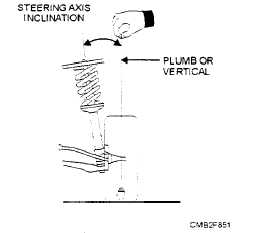
Figure 8-50. - A. Toe-in; B. Toe-out.
measured at the hub height. Toe-in causes the wheels to point inward at the front.
TOE-OUT results when the front of the wheels are farther apart than the rear. Toe-out causes the front of the wheels to point away from each other.
The type of drive (rear or front wheel) determines the toe settings. Rear-wheel drive vehicles are usually set to have TOE-IN at the front wheels. This design is due to as a result of the front wheels moving outward while driving, resulting in toe-out. By adjusting the wheels for a slight toe-in (1/16 to 1/4 in.), the wheels and tires will roll straight ahead when driving.
Front-wheel drive vehicles require different adjustment for toe. This is due to the front wheels driving the vehicle and are pushed forward by engine torque. This makes the wheel toe-in or point inward while driving. To compensate for this. front-wheel drive vehicles have the front wheels adjusted for a slight toe-out (1/16 inch). This adjustment will give the front end a zero toe setting. as the vehicle travels down the road.
Steering Axis Inclination
Steering axis inclination (SAI) (fig. 8-51) is the angle away from the vertical, formed by the inward tilt of the kingpin, ball joints, or MacPherson strut tube. Steering axis inclination is always an inward tilt regardless of whether the wheel tilts inward or outward. Steering axis inclination is NOT a tire-wearing angle. As with caster it aids directional stability by helping the steering wheel to return to the straight-ahead position.

Figure 8-51. - Steering axis inclination angle.
Continue Reading